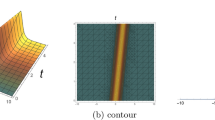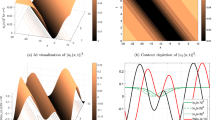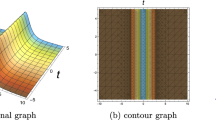Abstract
In this paper, the stochastic Schrödinger–Hirota equation with spatiotemporal dispersion and parabolic law nonlinearity is studied from the field of nonlinear optics, which is usually used to describe the optical soliton propagation in birefringent fibers. Firstly, the stochastic Schrödinger–Hirota equation is converted into nonlinear ordinary differential equation by using the traveling wave transformation. Secondly, the optical soliton solutions of the stochastic Schrödinger–Hirota equation are obtained by using the complete discriminant system method. Finally, three-dimensional, two-dimensional, and contour maps of optical soliton solutions of the stochastic Schrödinger–Hirota equation are drawn by using the Maple 2022 software. The optical soliton solutions obtained in this article can further help researchers understand the propagation of optical solitons in birefringent fibers.
Similar content being viewed by others
Avoid common mistakes on your manuscript.
Introduction
In recent years, the study of optical solitons in nonlinear partial differential equation (NLPDE) [1,2,3,4,5,6,7,8,9,10,11,12,13,14,15,16,17,18,19,20,21,22,23,24,25] has become a hot topic in the field of nonlinear science. The construction of optical soliton solutions of NLPDE can further explain scientific problems from the fields of physics, nonlinear optics and engineering technology. Therefore, many experts and scholars [26,27,28,29,30,31,32,33,34,35,36] have devoted themselves to the study of optical solitons in NLPDE. However, in the fields of natural science and engineering technology, the occurrence of random phenomena is inevitable [37, 38]. Therefore, the problem of considering the solution of NLPDE with random noise is a very difficult problem that has puzzled mathematicians and physicists [39,40,41,42,43,44,45,46,47,48,49,50,51]. Therefore, the main purpose of this paper is to construct optical soliton solutions for a class of stochastic NLPDE.
In this article, we consider the following the stochastic Schrödinger–Hirota equation in birefringent fibers with spatiotemporal dispersion and parabolic law nonlinearity [52]
where \(\psi (t,x)\) and \(\phi (t,x)\) represent the soliton profiles. \(a_{j}\) and \(b_{j}\)(\(j=1,2\)) stand for the coefficients of chromatic dispersions terms and spatio-temporal dispersion terms, respectively. \(c_{j}\) and \(d_{j}\)(\(j=1,2\))represent the coefficients of self-phase modulation and cross-phase modulation terms, respectively. \(f_{j}\), \(e_{j}\) and \(g_{j}\) (\(j=1,2\)) stand for nonlinear terms. \(\alpha _{j}\) and \(\lambda _{j}\)(\(j=1,2\)) are the self-steepening terms. \(v_{j}\) and \(\theta _{j}\)(\(j=1,2\)) represent the nonlinear dispersion terms. \(\frac{d\omega _{j}(t)}{dt}\)(\(j=1,2\)) are the white noises. \(\omega _{j}(t)\)(\(j=1,2\)) represents the standard Wiener processes. \(\sigma _{j}\)(\(j=1,2\)) stands for the noises strength. In [52], Elsayed et al. obtained the optical soliton solutions of Eq. (1.1) using the Jacobi-elliptic expansion approach and the extended auxiliary equation algorithm, respectively. The main purpose of this article is to construct optical soliton solutions for equation Eq. (1.1) using the complete discriminant system method.
The rest of this article is organized as follows: In Sect. 2, Eq. (1.1) is transformed into the ODEs using traveling wave transformation. Moreover, the optical soliton solutions of stochastic Schrödinger–Hirota equation are obtained. In Sect. 3, a brief summary is presented.
Optical soliton solutions of Eq. (1.1)
Mathematical analysis
Firstly, let’s consider the following transformation
where \(\Psi\) and \(\Phi\) represent the amplitude portions of the solitons. \(\eta _{j}(t,x)\), \(k_{j}\), \(\Omega _{j }\) and \(\theta _{j}\) (\(j=1,2\)) stand for the phase amplitude format, the frequencies of the solitons, the wave numbers and phase constants, respectively. v represents the soliton velocity. So, substituting Eq. (2.1) into Eq. (1.1) yields the real parts:
and the imaginary parts:
Next, let be the transformation \(\Phi (\xi )=A\Psi (\xi )\), where A is a nonzero constant. Thus, Eqs. (2.2) and (2.3) can be convert into
and
Integrating Eq. (2.5) and assuming an integral constant of zero, we obtain
By the linearly independent principle on Eq. (2.6) yields
Therefore, Eq. (2.3) are equivalent under following conditions
Consequently, the velocity of the soliton can be obtained from Eq. (2.8)
and
satisfying \((a_{1}-b_{1}v)(c_{2}+k_{2}\lambda _{2}+k_{2}\theta _{2})\ne (a_{2}-b_{2}v)d_{1}\) and \((a_{2}-b_{2}v)(c_{1}+k_{1}\lambda _{1}+k_{1}\theta _{1})\ne (a_{1}-b_{1}v)d_{2}\).
Thus, the first equation of Eq. (2.4) can be rewritten as
where \(\Theta _{1}=\frac{e_{1}+A^{2}f_{1}+A^{4}g_{1}}{a_{1}-b_{1}v}\), \(\Theta _{2}=-\frac{A^{2}d_{1}+c_{1}+k_{1}\lambda _{1}+k_{1}\theta _{1}}{a_{1}-b_{1}v}\) and \(\Theta _{3}=-\frac{a_{1}k_{1}^{2}-k_{1}\alpha _{1}+(\Omega _{1}-\sigma _{1}^{2})(1-b_{1}k_{1})}{a_{1}-b_{1}v}\) satisfying \(a_{1}\ne b_{1}v\).
Multiplying both sides of Eq. (2.11) by \(\Phi (\xi )\) and integrating once with respect to \(\xi\), we have
where c is integral constant.
Setting \(\Xi (\xi )=\Psi ^{2}(\xi )\), then the integral expression of Eq. (2.12) is
where \(P=\frac{3\Theta _{2}}{2\Theta _{1}}\), \(Q=\frac{2\Theta _{3}}{\Theta _{2}}\) and \(D=\frac{6c}{\Theta _{1}}\) satisfying \(\Theta _{1}\ne 0\).
Optical soliton solutions of Eq. (1.1)
Assume that \(F(\Xi )=\Xi ^{3}+P\Xi ^{2}+Q\Xi +D\), \(\Delta =-27(\frac{2P^{3}}{27}+D-\frac{PQ}{3})^{2}-4(Q-\frac{P^{2}}{3})^{3}\) and \(\Gamma =Q-\frac{P^{2}}{3}\). Here, when \(\Theta _{3}>0\), we take \(\varepsilon =1\). Conversely, when \(\Theta _{3}<0\), we take \(\varepsilon =-1\). Therefore, according to the complete discriminant system of third-order polynomials, we can obtain the optical soliton solution of Eq. (1.1).
-
(i)
\(\Delta =0, \Gamma <0, \varepsilon =1\). Suppose that \(F(\Xi )=\Xi ^{3}+P\Xi ^{2}+Q\Xi +D=(\Xi -\alpha )^{2}(\Xi -\beta )\), where \(\alpha\) and \(\beta\) are the real constants satisfying \(\alpha \ne \beta\). When \(\alpha >\beta\) and \(\Xi >\beta\), or when \(\alpha <0\) and \(\Xi <0\), we can obtain the solution of Eq. (1.1) from Eq. (2.13)
$$\begin{aligned}{} & {} \pm 2\sqrt{\frac{\Theta _{3}}{3}}(\xi -\xi _{0})\nonumber \\{} & {} \quad =\frac{1}{\alpha (\alpha -\beta )}\ln \frac{(\sqrt{\alpha (\Xi -\beta )}-\sqrt{\Xi (\alpha -\beta )})^{2}}{|\Xi -\alpha |}. \end{aligned}$$(2.14)When \(\alpha >\beta\) and \(\Xi <0\), or when \(\alpha <\Xi\) and \(\Xi <\beta\), we can obtain the solution of Eq. (1.1) from Eq. (2.13)
$$\begin{aligned}{} & {} \pm 2\sqrt{\frac{\Theta _{3}}{3}}(\xi -\xi _{0})\nonumber \\{} & {} \quad =\frac{1}{\alpha (\alpha -\beta )}\ln \frac{(\sqrt{-\alpha (\Xi -\beta )}-\sqrt{\Xi (\beta -\alpha )})^{2}}{|\Xi -\alpha |}. \end{aligned}$$(2.15)When \(\beta>\alpha >0\), we can obtain the solution of Eq. (1.1) from Eq. (2.13)
$$\begin{aligned}{} & {} \pm 2\sqrt{\frac{\Theta _{3}}{3}}(\xi -\xi _{0})\nonumber \\{} & {} \quad =\frac{1}{\alpha (\beta -\alpha )}\arcsin \frac{\alpha (\Xi -\beta )+\Xi (\alpha -\beta )}{\beta |\Xi -\alpha |}. \end{aligned}$$(2.16) -
(ii)
\(\varepsilon =-1\)
When \(\alpha >\beta\) and \(\Xi >\beta\), or when \(\alpha <0\) and \(\Xi <0\), we can obtain the solution of Eq. (1.1) from Eq. (2.13)
When \(\alpha >\beta\) and \(\Xi <0\), or when \(\alpha <0\) and \(\Xi <\beta\), we can obtain the solution of Eq. (1.1) from Eq. (2.13)
When \(\beta>\alpha >0\), we can obtain the solution of Eq. (1.1) from Eq. (2.13)
Case II. If \(\Delta =0\), \(\Gamma =0\), then \(F(\Xi )=(\Xi -\rho )^{3}\), where \(\rho\) is the real number.
-
(i)
\(\varepsilon =1\) If \(\Xi >\rho\) and \(\Xi >0\), or if \(\Xi <\rho\) and \(\Xi <0\), we can obtain the solution of Eq. (1.1) from Eq. (2.13)
$$\begin{aligned}{} & {} \psi _{1}(t,x)=\;\pm \;[\frac{3\rho }{\rho ^{2}\Theta _{1}(x-vt-\xi _{0})^{2}-3}\nonumber \\{} & {} \quad +\rho ]^{\frac{1}{2}}{\textbf{e}}^{i[\eta _{1}(t,x) +\sigma _{1}\omega _{1}(t)-\sigma _{1}^{2}t]}. \end{aligned}$$(2.20) -
(ii)
\(\varepsilon =-1\) If \(\Xi >\rho\) and \(\Xi <0\), or if \(\Xi <\rho\) and \(\Xi >0\), we can obtain the solution of Eq. (1.1) from Eq. (2.13)
$$\begin{aligned}{} & {} \psi _{2}(t,x)=\;\pm\; [\frac{3\rho }{-\rho ^{2}\Theta _{1}(x-vt-\xi _{0})^{2}-3}\nonumber \\{} & {} \quad +\rho ]^{\frac{1}{2}}{\textbf{e}}^{i[\eta _{1}(t,x)+\sigma _{1}\omega _{1}(t)-\sigma _{1}^{2}t]}. \end{aligned}$$(2.21)
Case III. If \(\Delta >0\), \(\Gamma <0\), \(F(\Xi )=\;(\Xi -\theta _{1})(\Xi -\theta _{2})(\Xi -\theta _{3})\), where \(\theta _{1}\), \(\theta _{2}\) and \(\theta _{3}\) are real numbers satisfying \(0<\theta _{1}<\theta _{2}<\theta _{3}\).
-
(i)
\(\varepsilon =1\) When \(\Xi >0\) and \(\Xi <\theta _{3}\), we can obtain the solution of Eq. (1.1) from Eq. (2.13)
$$\begin{aligned} \psi _{3}(t,x)= & {} \pm \sqrt{\frac{-\theta _{1}\theta _{3}{{\textbf{s}}}{{\textbf{n}}}^{2}(\sqrt{-\theta _{2}(\theta _{1}-\theta _{3})}\sqrt{\frac{\Xi _{1}}{3}}(x-vt-\xi _{0}),m)}{-\theta _{3}{{\textbf{s}}}{{\textbf{n}}}^{2}(\sqrt{-\theta _{2}(\theta _{1}-\theta _{3})}\sqrt{\frac{\Theta _{1}}{3}}(x-vt-\xi _{0}),m)-(\theta _{1}-\theta _{3})}}{\textbf{e}}^{i[\eta _{1}(t,x)+\sigma _{1}\omega _{1}(t)-\sigma _{1}^{2}t]}, \end{aligned}$$(2.22)$$\begin{aligned} \psi _{4}(t,x)= & {} \pm \sqrt{\frac{\theta _{3}(\theta _{1}-\theta _{2}){{\textbf{s}}}{{\textbf{n}}}^{2}(\sqrt{-\theta _{2}(\theta _{1}-\theta _{3})}\sqrt{\frac{\Theta _{1}}{3}}( x-vt-\xi _{0}),m)-\theta _{2}(\theta _{1}-\theta _{3})}{(\theta _{1}-\theta _{2}){{\textbf{s}}}{{\textbf{n}}}^{2}(\sqrt{-\theta _{2}(\theta _{1}-\theta _{3})}\sqrt{\frac{\Theta _{1}}{3}}(x-vt-\xi _{0}),m)-(\theta _{1}-\theta _{3})}}{\textbf{e}}^{i[\eta _{1}(t,x)+\sigma _{1}\omega _{1}(t)-\sigma _{1}^{2}t]}, \end{aligned}$$(2.23)where \(m^{2}=\frac{\theta _{3}(\theta _{1}-\theta _{2})}{\theta _{2}(\theta _{1}-\theta _{3})}\).
-
(ii)
\(\varepsilon =-1\)When \(\theta _{3}<\Xi <\theta _{2}\), we can obtain the solution of Eq. (1.1) from Eq. (2.13)
$$\begin{aligned} \psi _{5}(t,x)= & {} \pm \sqrt{\frac{-\theta _{1}\theta _{2}{{\textbf{s}}}{{\textbf{n}}}^{2}(\sqrt{-\theta _{2}(\theta _{1}-\theta _{3})}\sqrt{\frac{\Theta _{1}}{3}}(x-vt-\xi _{0}),m)+\theta _{1}\theta _{2}}{-\theta _{1}{{\textbf{s}}}{{\textbf{n}}}^{2}(\sqrt{-\theta _{2}(\theta _{1}-\theta _{3})}\sqrt{\frac{\Theta _{1}}{3}}(x-vt-\xi _{0}),m)+\theta _{3}}}{\textbf{e}}^{i[\eta _{1}(t,x)+\sigma _{1}\omega _{1}(t)-\sigma _{1}^{2}t]}, \end{aligned}$$(2.24)$$\begin{aligned} \psi _{6}(t,x)= & {} \pm \sqrt{\frac{-\theta _{2}\theta _{3}}{(\theta _{2}-\theta _{3}){{\textbf{s}}}{{\textbf{n}}}^{2}(\sqrt{-\theta _{2}(\theta _{1}-\theta _{3})}\sqrt{\frac{\Theta _{1}}{3}}(x-vt-\xi _{0}),m)-\theta _{2}}}{\textbf{e}}^{i[\eta _{1}(t,x)+\sigma _{1}\omega _{1}(t)-\sigma _{1}^{2}t]}, \end{aligned}$$(2.25)where \(m^{2}=\frac{\theta _{1}(\theta _{2}-\theta _{3})}{\theta _{2}(\theta _{1}-\theta _{3})}\).
Case IV. If \(\Delta <0\), \(F(\Xi )=(\Xi -\vartheta _{1})[(\Xi -\vartheta _{2})^{2}+\vartheta _{3}^{2}]\), where \(\vartheta _{1}\), \(\vartheta _{2}\) and \(\vartheta _{3}\) are real numbers, and \(\vartheta _{1}>0\), \(\theta _{2}>0,\theta _{3}>0\). So, we can obtain the solution of Eq. (1.1) from Eq. (2.13), where the positive sign corresponds to \(\varepsilon = 1\) and the symbol corresponds to \(\varepsilon = -1\).
where \(d_{1}=\frac{1}{2}\vartheta _{1}(d_{3}-d_{4})\), \(d_{2}=\frac{1}{2}\vartheta _{1}(\vartheta _{4}-d_{3})\), \(d_{3}=\vartheta _{1}-\vartheta _{2}-\frac{\vartheta _{3}}{m_{1}}\), \(d_{4}=\vartheta _{1}-\vartheta _{2}-\vartheta _{3}m_{1}\), \(E=\frac{\vartheta _{3}^{2}-\vartheta _{2}(\vartheta _{1}-\vartheta _{2})}{\vartheta _{1}\vartheta _{3}}\), \(m_{1}=E\pm \sqrt{E^{2}+1}\) and \(m^{2}=\frac{1}{1+m_{1}^{2}}\).
Numerical simulation
When \(\Theta _{1}=-1,\Theta _{2}=2,\Theta _{3}=3,\xi _{0}=0,v=1,c=\frac{1}{6}\), we can plot three-dimensional diagram, two-dimensional diagram and contour plot of optical soliton solution \(|\psi _{1}(t,x)|\) as shown in Fig. 1. When \(\Theta _{1}=1,\Theta _{2}=-4,\Theta _{3}=\frac{11}{2},\xi _{0}=0,v=1,c=-1\), we can plot three-dimensional diagram, two-dimensional diagram and contour plot of optical soliton solution \(|\psi _{3}(t,x)|\)as shown in Fig. 2.
Conclusion
In the paper, the optical soliton solutions of stochastic Schrödinger–Hirota equation with spatiotemporal dispersion and parabolic law nonlinearity are investigated by using the complete discriminant system method. Moreover, we obtained seven sets of solutions and implicit function solutions, and we also draw three-dimensional diagram, two-dimensional diagram and contour plot of the solitons \(|\psi _{1}(t,x)|\) and \(|\psi _{3}(t,x)|\), which are meaningful for us to further understand the propagation of optical solitons. Compared with reference [52], our obtained solutions are more abundant.
Data availability
No data were used for the research described in the article.
References
E.M.E. Zayed, R.M.A. Shohib, A. Biswas et al., Optical solitons and conservation laws associated with Kudryashov’s sextic power-law nonlinearity of refractive index. Ukr. J. Phys. Opt. 22, 38 (2021)
A.R. Adem, B. Ntsime, A. Biswas et al., Stationary optical solitons with nonlinear chromatic dispersion for Lakshmanan–Porsezian–Daniel model having Kerr law of nonlinear refractive index. Ukr. J. Phys. Opt. 22, 83 (2021)
A. Biswas, J. Edoki, P. Guggilla et al., Cubic-quartic optical solitons in Lakshmanan–Porsezian–Daniel model derived with semi-inverse variational principle. Ukr. J. Phys. Opt. 22, 123 (2021)
Y. Yıldırım, A. Biswas, P. Guggilla et al., Optical solitons in fibre Bragg gratings with third- and fourth-order dispersive reflectivities. Ukr. J. Phys. Opt. 22, 239 (2021)
Y. Yıldırım, A. Biswas, A. Dakova et al., Cubic-quartic optical solitons having quadratic-cubic nonlinearity by sine-Gordon equation approach. Ukr. J. Phys. Opt. 22, 255 (2021)
E.M.E. Zayed, R. Shohib, M. Alngar et al., Optical solitons in the Sasa-Satsuma model with multiplicative noise via Itô calculus. Ukr. J. Phys. Opt. 23, 9 (2022)
Y. Yıldırım, A. Biswas, S. Khan et al., Highly dispersive optical soliton perturbation with Kudryashov’s sextic-power law of nonlinear refractive index. Ukr. J. Phys. Opt. 23, 24 (2022)
O. González-Gaxiola, A. Biswas, Y. Yıldırım et al., Highly dispersive optical solitons in birefringent fibres with non-local form of nonlinear refractive index: Laplace-Adomian decomposition. Ukr. J. Phys. Opt. 23, 68 (2022)
A.A. Al Qarni, A.M. Bodaqah, A.S.H.F. Mohammed et al., Cubic-quartic optical solitons for Lakshmanan–Porsezian–Daniel equation by the improved Adomian decomposition scheme. Ukr. J. Phys. Opt. 23, 228 (2022)
A.A. Al Qarni, A.M. Bodaqah, A.S.H.F. Mohammed et al., Dark and singular cubic-quartic optical solitons with Lakshmanan–Porsezian–Daniel equation by the improved adomian decomposition scheme. Ukr. J. Phys. Opt. 24, 46 (2023)
A. Kukkar, S. Kumar, S. Malik et al., Optical solitons for the concatenation model with Kurdryashov’s approaches. Ukr. J. Phys. Opt. 24, 155 (2023)
A. Biswas, J. Vega-Guzman, Y. Yıldırım et al., Optical solitons for the concatenation model with power-law nonlinearity: undetermined coefficients. Ukr. J. Phys. Opt. 24, 185 (2023)
E.M.E. Zayed, M.E.M. Alngar, A. Biswas et al., Optical solitons in fiber Bragg gratings with quadratic-cubic law of nonlinear refractive index and cubic-quartic dispersive reflectivity. Proc. Estonian Acad. Sci. 71, 165 (2022)
O. González-Gaxiola, A. Biswas, Y. Yıldırım et al., Optical solitons in fiber Bragg gratings with quadratic-cubic law of nonlinear refractive index and cubic-quartic dispersive reflectivity. Proc. Estonian Acad. Sci. 71, 213 (2022)
Y. Yıldırım, A. Biswas, A.H. Kara et al., Optical soliton perturbation and conservation law with Kudryashov’s refractive index having quadrupled power-law and dual form of generalized nonlocal nonlinearity. Semicond. Phys. Quantum Electron. Optoelectron. 24, 64 (2021)
Y. Yıldırım, A. Biswas, S. Khan et al., Embedded solitons with \(\chi ^{2}\) and \(\chi ^{3}\) nonlinear susceptibilities. Semicond. Phys. Quantum Electron. Optoelectron. 24, 160 (2021)
A. Biswas, A. Dakova, S. Khan et al., Cubic-quartic optical soliton perturbation with Fokas–Lenells equation by semi-inverse variation. Semicond. Phys. Quantum Electron. Optoelectron. 24, 431 (2021)
M.M.A. Khater, Novel computational simulation of the propagation of pulses in optical fibers regarding the dispersion effect. Int. J. Mod. Phys. B 37, 2350083 (2023)
A. Biswas, D. Milovic, M. Edwards, Mathematical Theory of Dispersion-Managed Optical Solitons (Springer, Berlin, 2010)
S. Tarla, K.K. Ali, R. Yilmazer et al., New optical solitons based on the perturbed Chen-Lee-Liu model through Jacobi elliptic function method. Opt. Quant. Electron. 54, 131 (2022)
Z. Li, C. Huang, Bifurcation, phase portrait, chaotic pattern and optical soliton solutions of the conformable Fokas–Lenells model in optical fibers. Chaos Solitons Fractals 169, 113237 (2023)
N. Raza, M.H. Rafiq, A. Bekir et al., Optical solitons related to (2+1)-dimensional Kundu-Mukherjee-Naskar model using an innovative integration architecture. J. Nonlinear Opt. Phys. Mater. 31, 2250014 (2022)
M.M. Haque, M.A. Akbar, M.S. Osman, Optical soliton solutions to the fractional nonlinear Fokas–Lenells and paraxial Schrödinger equations. Opt. Quantum Electron. 54, 764 (2022)
Z. Li, C. Huang, B. Wang, Phase portrait, bifurcation, chaotic pattern and optical soliton solutions of the Fokas–Lenells equation with cubic-quartic dispersion in optical fibers. Phys. Lett. A 465, 128714 (2023)
L. Tang, Bifurcations analysis and multiple solitons in birefringent fibers with coupled Schrödinger–Hirota equation. Chaos Solitons Fractals 161, 112383 (2022)
Y. Alhojilan, H.M. Ahmed, Novel analytical solutions of stochastic Ginzburg–Landau equation driven by Wiener process via the improved modified extended tanh function method. Alex. Eng. J. 72, 269–274 (2023)
T.A. Khalil, N. Badra, H.M. Ahmed et al., Optical solitons and other solutions for coupled system of nonlinear Biswas–Milovic equation with Kudryashov’s law of refractive index by Jacobi elliptic function expansion method. Optik 253, 168540 (2022)
A.R. Seadawy, H.M. Ahmed, W.B. Rabie et al., An alternate pathway to solitons in magneto-optic waveguides with triple-power law nonlinearity. Optik. 231, 166840 (2021)
M. Ahmed, A. Zaghrout, H.M. Ahmed, Construction of solitons and other solutions for NLSE with Kudryashov’s generalized nonlinear refractive index. Alex. Eng. J. 64, 391 (2023)
Y. Alhojilan, H.M. Ahmed, W.B. Rabie, Stochastic solitons in birefringent fibers for Biswas–Arshed equation with multiplicative white noise via Itô calculus by modified extended mapping method. Symmetry. 15, 207 (2023)
M.M.A. Khater, S.H. Alfalqi, J.F. Alzaidi et al., Novel soliton wave solutions of a special model of the nonlinear Schrödinger equations with mixed derivatives. Results Phys. 47, 106367 (2023)
H. Rezazadeh, A.G. Davodi, D. Gholami, Combined formal periodic wave-like and soliton-like solutions of the conformable Schrödinger-KdV equation using the \((G^{\prime }/G)\)-expansion technique. Results Phys. 47, 106352 (2023)
L. Tang, Phase characterization and optical solitons for the stochastic nonlinear Schrödinger equation with multiplicative white noise and spatio-temporal dispersion via Itô calculus. Optik 279, 170748 (2023)
N.A. Kudryashov, Optical solitons of the Schrödinger–Hirota equation of the fourth order. Optik 274, 170587 (2023)
Z. Li, Bifurcation and traveling wave solution to fractional Biswas–Arshed equation with the beta time derivative. Chaos Solitons Fractals 160, 112249 (2022)
H. Cakicioglu, M. Cinar, A. Secer et al., Optical solitons for Kundu–Mukherjee–Naskar equation via enhanced modified extended tanh method. Opt. Quant. Electron. 55, 400 (2023)
K.Q. Tran, D.H. Nguyen, Exponential stability of impulsive stochastic differential equations with Markovian switching. Syst. Control Lett. 162, 105178 (2022)
Q. Zhu, \(p\)th moment exponential stability of impulsive stochastic functional differential equations with Markovian switching. J. Franklin Inst. 351(7), 3965–3986 (2014)
M.M.A. Khater, Novel computational simulation of the propagation of pulses in optical fibers regarding the dispersion effect. Int. J. Mod. Phys. B 37, 2350083 (2023)
M.M.A. Khater, A hybrid analytical and numerical analysis of ultra-short pulse phase shifts. Chaos Solitons Fractals 169, 113232 (2023)
M.M.A. Khater, S.H. Alfalqi, J.F. Alzaidi et al., Analytically and numerically, dispersive, weakly nonlinear wave packets are presented in a quasi-monochromatic medium. Results Phys. 46, 106312 (2023)
M.M.A. Khater, Prorogation of waves in shallow water through unidirectional Dullin–Gottwald–Holm model; computational simulations. Int. J. Mod. Phys. B 37, 2350071 (2023)
M.M.A. Khater, In solid physics equations, accurate and novel soliton wave structures for heating a single crystal of sodium fluoride. Int. J. Mod. Phys. B. 37, 2350068 (2023)
M.M.A. Khater, Nonlinear elastic circular rod with lateral inertia and finite radius: dynamical attributive of longitudinal oscillation. Int. J. Mod. Phys. B 37, 2350052 (2023)
M.M.A. Khater, X. Zhang, R.A.M. Attia, Accurate computational simulations of perturbed Chen–Lee–Liu equation. Results Phys. 45, 106227 (2023)
M.M.A. Khater, Multi-vector with nonlocal and non-singular kernel ultrashort optical solitons pulses waves in birefringent fibers. Chaos Solitons Fractals 167, 113098 (2023)
M.M.A. Khater, Physics of crystal lattices and plasma; analytical and numerical simulations of the Gilson-Pickering equation. Results Phys. 44, 106193 (2023)
R.A.M. Attia, X. Zhang, M.M.A. Khater, Analytical and hybrid numerical simulations for the (2+1)-dimensional Heisenberg ferromagnetic spin chain. Results Phys. 43, 106045 (2023)
T. Han, Z. Li, K. Zhang, Exact solutions of the stochastic fractional long-short wave interaction system with multiplicative noise in generalized elastic medium. Results Phys. 44, 106174 (2022)
W.W. Mohammed, N. lqbal, A.M. Albalahi et al., Brownian motion effects on analytical solutions of a fractional-space long-short-wave interaction with conformable derivative. Results Phys. 35, 105371 (2022)
M. Mouy, H. Boulares, S. Alshammari et al., On averaging principle for Caputo–Hadamard fractional stochastic differential pantograph equation. Fractal Fract. 7, 31 (2023)
E.M.E. Zayed, R.M.A. Shohib, M.E.M. Alngar, Dispersive optical solitons in birefringent fibers for stochastic Schrödinger–Hirota with parabolic law nonlinearity and spatiotemporal dispersion having multiplicative white noise. Optik 278, 170736 (2022)
Author information
Authors and Affiliations
Corresponding author
Additional information
Publisher's Note
Springer Nature remains neutral with regard to jurisdictional claims in published maps and institutional affiliations.
Rights and permissions
Springer Nature or its licensor (e.g. a society or other partner) holds exclusive rights to this article under a publishing agreement with the author(s) or other rightsholder(s); author self-archiving of the accepted manuscript version of this article is solely governed by the terms of such publishing agreement and applicable law.
About this article
Cite this article
Li, Z., Zhu, E. Optical soliton solutions of stochastic Schrödinger–Hirota equation in birefringent fibers with spatiotemporal dispersion and parabolic law nonlinearity. J Opt 53, 1302–1308 (2024). https://doi.org/10.1007/s12596-023-01287-7
Received:
Accepted:
Published:
Issue Date:
DOI: https://doi.org/10.1007/s12596-023-01287-7






